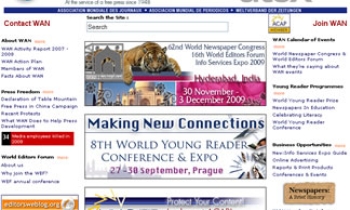NEW YORK: For years, publishers have relied -- often to their detriment -- upon the metric of paid circulation. But circulation for the core product has been on a long, steady decline, causing some to suggest that print is on its way out.
The industry has touted the notion of readership -- a metric that takes into account how many people read the paper whether they buy it or not -- for years, but has often taken halfhearted steps toward giving it true legitimacy.
Then there's the confounding, if promising, online angle. If you count Web traffic, newspapers are actually more popular than ever.
Many readers feel they no longer want to get their hands dirty reading the newspaper, but they are still viewing them online. But this raises the question, how many are uniques, and how many are duplicate readers who also check out the print edition?
Because of the opportunities afforded by a growing online audience, as well as a push to restore credibility to print circulation numbers following last year's circ scandals, efforts to exploit new methods of measurement are being encouraged. Not only is the industry emphasizing readership, but also total audience, which takes Web readers into account.
"We have for years allowed ourselves to be held hostage to one metric only," says Jay R. Smith, chairman of the Newspaper Association of America (NAA) and president of Cox Newspapers Inc. "Newspapers have for the last couple of years been finding whole new pockets of audiences for which they get no credit."
Now, in addition to embracing print readership numbers, publishers are weaving in online figures (in addition to numbers for niche and youth publications). A Web site's audience measurement is an increasingly valuable piece of data that, when added to the print data, shows that newspapers are in fact reaching more people than ever -- even if many of those readers do not yet pay for the privilege. While it would seem the industry is finally warming to the concept of total audience, it's only the first of many steps to come -- including the challenge of getting the right information to the right advertisers.
While some in the industry feel the new accounting may be too "cutting edge" (in the words of one) for advertisers to comprehend, Gary Meo, a vice president at Scarborough Research, says local numbers are proving that newspapers have a strong market footprint. "The perception that newspapers are losing readers in droves isn't true," he asserts. "They're losing them in a trickle. We do see newspaper Web site audiences growing, and we see them being younger. So the myth that newspapers are not reaching younger people needs to be dispelled."
That may be, but two critical things now have to happen: The newspaper industry has to put some more muscle behind the concept of total audience, and advertisers need to be ready to buy into it. The latest push came from the NAA, which in early October released an industry wide study on print and online readership called the Newspaper Audience Database (NADbase). The report culls together audience demographic and online data from Scarborough Research, Nielsen//NetRatings, and to a lesser extent, The Gallup Organization, for about 100 major newspapers in the country to be issued twice a year.
"The first challenge is to tell a story. That is really what the NADbase is about," NAA's Smith explains. "We need to develop a vocabulary that we as newspaper folks can articulate, and advertisers can appreciate. When you broaden [the notion] to include other publications, what you discover is, all of a sudden we are no longer touching 55% but closer to 75% of all adults. You can't go to one TV station or a cluster of radio stations and begin to get an audience like that."
The NADbase alphabetically lists the papers by designated market area (DMA), and breaks out the paper's daily, Sunday, and cumulative reach by gender, age group, and household income. It then takes into account daily and weekly readers for print and for online readers in the past 30 days, showing unique-visitor numbers and page views.
So if there's a true "bottom line" number, it is the one that includes print readership as well as "unduplicated" Web users who are only reading the paper online.
The Des Moines (Iowa) Register, for example, reaches 70.1% (about 555,300 adults) of its market on a seven-day basis with its print product (using readership, not paid circ, numbers). But when its Web users for a given month -- who do not read print -- are added to the number of print readers, that reach rises modestly to 74.6% (591,235 adults).
At The Boston Globe, according to NADbase, adding the online "uniques" boosts reach by a more noticeable 8.7 percentage points.
Overall, the NADbase reports that nearly one-third of the Internet population, or 43 million visitors, visited newspaper Web sites in July 2005.
"Papers are getting more comfortable looking at these two audiences," says Miles Groves, president of MG Strategic Research in Washington, D.C. "They are trying to find value with their online audience."
Online revenue growth is suddenly not so minimal. Groves points to the growth of online advertising on newspaper Web sites, which has increased 20% to 30% in the past several quarters. Banc of America Securities reported that in the second quarter this year alone, online growth contributed close to 80% to ad-revenue growth at newspaper public companies.
Data For the New Mindset
With stats like those, it's no wonder that publishers have been seeking more detailed information on their print and online reach so they can offer advertisers an integrated package. Independent companies like The Media Audit and Scarborough Research are fine-tuning data to show how all of a newspaper's products stack up in a given market.
The Media Audit, a research firm based in Houston, pulls integrated data that melds print and online readership. For the online side, the company measures audience in three modes: past 30 days, past seven days, and yesterday.
"Our clients have been asking for this data and selling this way for at least six years," says Media Audit Executive Vice President Phillip Beswick. "Six, seven years ago there was a great thrust on the part of newspapers to go out and set up their own division to sell the Web. They realized they were jumping the gun." He says that now newspapers realize the core product coupled with the Web site can really extend market reach.
Executives at Scarborough noticed the same trend, and just recently overhauled the way it measures online audiences. In June it introduced Integrated Newspaper Audience, a report that tallies a newspaper's print and online readers.
This is not entirely new territory for Scarborough, which has been measuring online audiences for some time. The difference now is that the research firm is taking into account Web usage within the past seven days, as opposed to the past 30 days. (The NADbase, for now, uses Scarborough's past-30-day Web site information.)
"We saw an opportunity because our newspaper clients wanted to demonstrate they have a growing audience rather than a shrinking audience -- and that they are reaching a younger audience," says Meo, senior vice president, print/Internet at Scarborough. "Most newspapers pick those people up [by including] their Web sites."
Scarborough also ran the numbers to give a total snapshot of the industry. It found that 51.4% of adults read a daily newspaper, that 58% read a Sunday paper, and that 14% access a newspaper online.
The Austin American-Statesman, for example, reaches about 65% of its market, with 757,222 readers. Of that population, about 9% of its audience reads the newspaper (at Austin360.com and statesman.com) within a seven-day period exclusively online, according to Scarborough.
When the NAA ran the numbers for 100 newspapers, combining the average number of print readers with the average number of online readers and subtracting the dupes, it found that Web sites increase the total audience by an average of approximately 12%. Unsurprisingly, this was especially true among younger people, with adults 18 to 24 raising their numbers 16% and 25-to-34-year olds building their share by 19%.
Telling a New Story
Some newspapers have been embracing this model for some time, while others are just starting to get used to the idea. Says media economist Groves, "Newspapers only recently have been able to cogently tell this story."
The Tampa Tribune has been using total audience as a selling point for about 10 years, says Ted Stasney, the paper's market development director: "We had proprietary research that measured online audience and newspaper audience as well, to show the relationship between users and readers and the incremental value you would get from adding online."
Stasney explained that for a long time, the numbers revealed more duplication between the two mediums. Now more people, for better or worse, are going exclusively to the Web site. The paper can build various campaigns off that audience, especially in classified. "That's where I see lots of growth," he adds.
According to Scarborough, about 5% of the Tampa market exclusively reads the online product (TBO.com and TampaTrib.com) within a seven-day period. About 23% of adults only read the paper. Total "readership" comes to 34.5% when taking into account print and online.
Like the Tribune, The Atlanta Journal-Constitution is making progress when showing its market footprint. And like the Tribune, the paper is now gaining some traction with its online audience. "Five years ago, the online number didn't increase your reach -- but now you are adding 10 reach points," says Jim Wilson, the Journal-Constitution's director of research and audience development. "Now we are starting to use that number to show an increase in the total audience."
The Scarborough report shows that the Journal-Constitution has a total readership (including AJC.com and AccessAtlanta.com) of 2,376,466 people, or 56.1% of the market. Within its readership, 9% of the audience, or 222,804, read the paper exclusively online within a seven-day period.
The Sacramento Bee has been actively touting its market share. "It's become a fixed component in any major presentation. We talk about total exposure, total eyeballs, total penetration," says Gary Benjamin, strategic resources manager for the Bee. "We don't shortchange ourselves, if you know what I mean." According to NADbase, the Bee reaches about 43% of the total market with its online and print products.
Benjamin says that the Bee has been using this kind of data for the past seven years, but the industry still has a way to go in making this practice the norm. "Are we improving that? Yes. Is it a slow improvement? Yes." He adds there has been much more progress this year than in the past five years combined.
The Challenges Ahead
While it's good news that the industry is moving on total audience, it's really only the start of something potentially bigger. "I think I have to preface this by saying that I see [total audience] happening, but it's real early in the process," says John Kimball, the NAA's senior vice president and chief marketing officer. "The secret is going to be, can the newspapers slice and dice these audience vehicles in a such a way that they can make a compelling sales story?
"The harsh reality is, these advertisers are not necessarily looking for total coverage," he adds. "They have a demographic target. That's where the innovation is going to take place and that's where the hard work is."
Take The San Diego Union-Tribune. Using total audience, it reaches 66.3% of San Diego's designated market area. "We have discussed it," says Chris Jennewein, Internet operations director of SignOnSanDiego.com, referring to the total-audience metric. "But at this point, we list both circulation and readership on the print side and page views and unique users on the Internet side." The paper maintains separate sales staffs for print and online.
Although he's in favor of papers trying to combine their Web and print numbers, Jennewein says there are two different markets for print and online: "For most advertisers, it's too cutting-edge. I don't think the parameters have been established yet."
Even papers that have been compiling data to show total audience encounter problems when presenting this data to advertisers. Often, agencies and their clients aren't equipped to manage Web and print buys at the same time.
"The agency structure and the budget process is set up to look at each media individually," says Jason Klein, president and CEO of the Newspaper National Network (NNN). "By and large, this is a case where the sellers are out in front of the buyers."
Many agencies, for example, have different departments responsible for buying each medium. In some cases, clients use different companies for print and online buys. "If anything, buying Internet advertising is very complex and very specialized, and it's not getting any more simple," Klein says. Still, he believes the combined metric makes sense in terms of pushing the vitality of newspapers.
Bryan Jackson, director of newspaper investment at OMD in Atlanta -- he buys print for clients like Cingular Wireless -- says he constantly gets newspapers that pitch total audience. "Typically, we like to keep those separate for a couple of reasons," he says. "The delivery of the product is very different, and the usage is very different. Online is one of those strange things. Obviously, the newspaper Web sites are well-read, but basically I run the print-buying group." Online ad buying is handled out of another office.
Going Against the Grain
Even The New York Times, which according to NADbase reaches roughly 12 million unique users on the Web per month, finds selling total audience a difficult task. Denise Warren, senior vice president/chief advertising officer for the New York Times Media Group, says there's no straight way of looking at a combined audience.
"I will tell you it's rather complicated," she says. "The industry hasn't organized itself yet to take advantage of this. You have to go back to the clients and agencies, and many are still organized separately."
Warren does detect that some advertisers are warming to the concept. "The direction is moving toward combination purchasing," she says, noting that it largely depends on the type of client and the industry with which the group is dealing.
The Times organizes its sales pitch accordingly. Warren explains that in two categories, real estate and recruitment, the Times has a combined sales force. Otherwise, the sales force is structured separately, but the print and online sales staffs are prepared to come together at a client's request. If someone wants an integrated package, the Times can provide it. "Some really want to see [a combined audience] and take advantage of it. Others are not there yet," she explains.
The Washington Post faces the same problem, especially as its Web site reaches 40.5% of its market, according to the Media Audit. Stephen Hills, the newspaper's president and GM, says that while print ads make up the bulk of sales, he's seeing an increasing amount of advertisers interested in both, especially in the technology and travel sectors.
The Post maintains different sales staffs for each medium but they work closely together so they are coordinated, he adds.
Still a Hard Sell?
Sales calls don't always go over smoothly. If an account is looking at print and doesn't want to spend online, "you want to make sure the online person doesn't push the apple cart," says Hills. The same holds for the print salespeople: "If the advertiser wants to go online and the generalist isn't as familiar with online, they get nervous. There are pitfalls on both sides of the road, but it works out in the end."
The Sacramento Bee also maintains a separate sales staff for online that works closely with print. "Our objective is to get every print salesperson as comfortable with selling online as the online people are selling print," says the Bee's Benjamin.
The frustrations with getting print and Web salespeople acquainted with each other's areas arise partly from the differences between the two mediums. There's not enough "cookie cutter" online ad packages, Benjamin says, something that print people are very used to dealing with. The online people explain that every package can be customized -- one of the great benefits of the Web. "That is another roadblock making it difficult to the print side to integrate it into what you do. They don't even know what they are recommending," he says, but at least "they can open the door."
Benjamin even gets some old stalwarts like Albertsons grocery chain asking for integrated packages. Advertisers are a lot more open today than they were "even a year ago," he says of the combo packages.
The Dallas Morning News has latched onto total audience during the past 18 months. "We use the term 'audience' internally," says publisher James Moroney. "We can't quit talking about circulation, but we're trying to change our internal lexicon into one that talks about 'audience.'"
He admits it's easier to sell by combination print packages, like the youth-oriented Quick or the Hispanic Al Dia: "The challenge still is the education of the advertiser around how to use the Web effectively to move their product. The challenge for us is to internally educate our own sales force in how to use the Web effectively."
Of course, another danger with combined packages is that the industry still tends to discount the Web, giving up a banner ad for a nominal price (if not free) if an advertiser buys a print ad. But media analyst Miles Groves says there is evidence that the industry is shifting away from this mentality. Since online has been increasing 20% to 30% for several quarters, "you can't dismiss [online advertising] as a forced buy."
SignOnSanDiego's Jennewein thinks that discounting is still more common than not. "We will stay away from deals that are value-add," he says. "It's a curse phrase in the online industry. There was a time when newspaper Web sites provided no additional reach, but that time is gone."
Though promising, the NAA's Kimball is realistic about the metric. He expects the landscape to have changed drastically over the next three to four years. "What I've heard is, 'don't quit trying,'" he says. "Newspapers are getting high marks [from advertisers] for not just sitting back."
Jennifer Saba (jsaba@editorandpublisher.com) is an associate editor at E&P.









